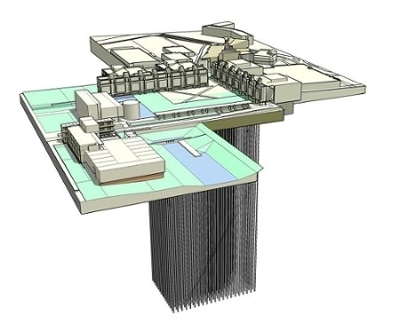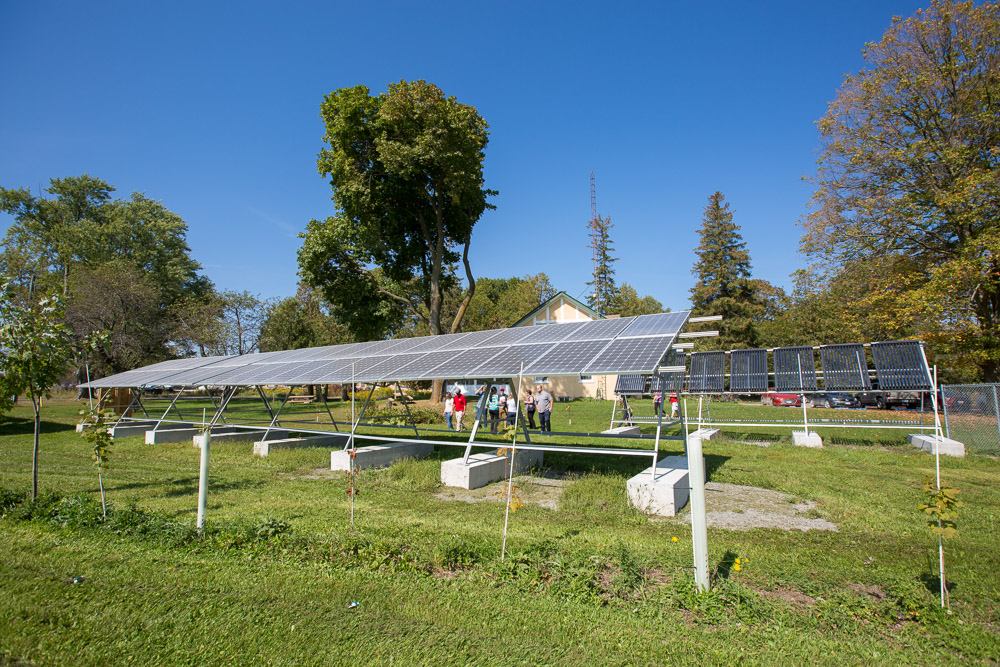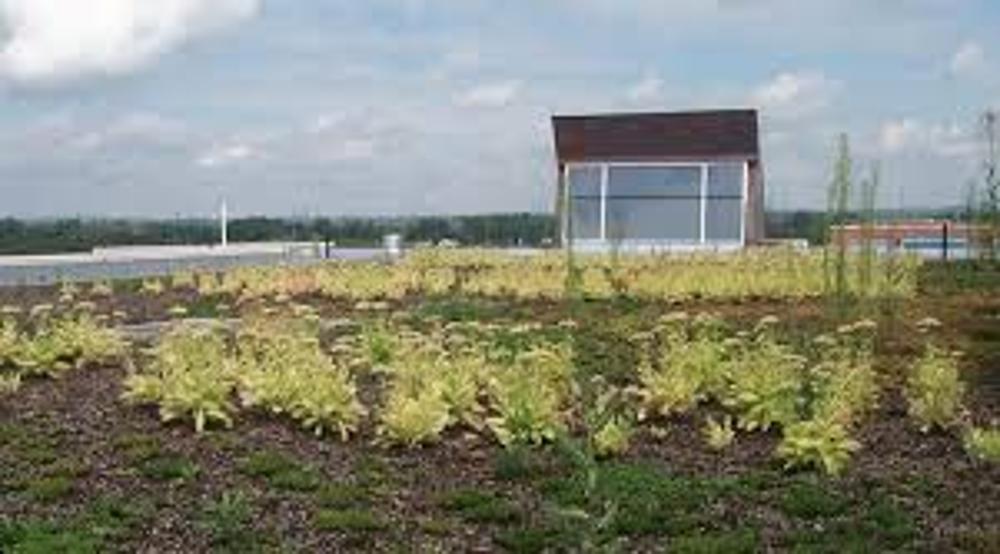Energy
Heating, cooling and ventilation
-
Geothermal Well Field

The university is home to one of the largest geothermal systems in North America--a 1,500-ton Borehole Thermal Energy Storage System (BTESS) located beneath the 7,500 square-metre quad at the heart of the complex.
The installation features more than 370 boreholes, each 180 metres deep, used for heating and cooling campus buildings. Water circulates through the underground network of 150 km of polypropylene piping.
- Winter operations: The geothermal system extracts heat from the earth and delivers it to the buildings.
- Summer operations: The system removes heat from the buildings and disperses it back into the ground.
-
Central heating and cooling plant
The university has a central plant that provides a comprehensive heating and cooling system for the entire North Oshawa campus. The efficient HVAC solutions, integrated with custom-designed geothermal systems, deliver 50 per cent better energy efficiency than the Model National Energy Code for Buildings (MNECB) requirements.
- Cooling system: Chillers utilize magnetic induction in a centrifugal compressor system for air conditioning. A series of heat exchangers, with a 30 per cent glycol mix, prevents coil freezing during winter.
- Energy recovery: Classrooms are equipped with an energy recovery wheel located just below the rooftop, which preheats outside air using heat recovered from exhaust air (71.7 per cent effectiveness).
- Laboratory safety: In laboratories, where air contamination is a major concern, a loop system is employed to reclaim waste heat.
- Supplemental heating: Three of six condensing boilers, each over 95 per cent efficient, provide supplemental heat for entrances, hallways, and other areas where doors are frequently opened and heat may not reach effectively.
-
Cogeneration plant
A ground-source heat exchanger serves as the primary source for heating and cooling at the central plant. The thermal energy produced at the plant is used to heat existing and new buildings on the shared campus of Ontario Tech and Durham College in North Oshawa. Additionally, the electricity generated at the plant helps reduce the electrical load from the provincial supply grid.
-
Ventilation
Ontario Tech's campus has a relatively high occupancy load but operates on a transient occupancy schedule. The mechanical systems are designed to efficiently meet the building ventilation requirements while adapting to the variable occupancy levels in various spaces.
- Demand ventilation strategy:
Carbon dioxide sensors implement a demand ventilation strategy, adjusting the ventilation supplied to each space based on its occupancy.
-
Outdoor ventilation:
To capture free cooling opportunities, 100 per cent outdoor ventilation is available for all building spaces. This allows ambient air to provide the necessary conditioning without mechanical cooling. -
Thermal energy recovery:
To reduce heating and cooling demands, three thermal energy recovery wheels are in the university’s ventilation system. These wheels capture both sensible and latent heat from the air that are exhausted from the buildings. -
Variable air volume systems:
The mechanical systems use variable air volume (VAV) technology, controlling the volume through variable frequency drives on the supply fan motors.
- Demand ventilation strategy:
-
Building automation systems
The facilities operate with computerized comprehensive building automation systems. All incoming electrical feeds are monitored with electronic metering to optimize ongoing building operations.
- Air quality control: Carbon dioxide monitors assess air quality and control the use of outside air.
-
Occupancy sensors: Centralized computer control systems turn off lights in unoccupied rooms using occupancy sensors.
-
Temperature monitoring: These systems monitor air temperatures and automatically regulate other aspects of the interior space.
-
Solar generation
Photovoltaic solar arrays are located on a variety of campus buildings:
CLEAN ENERGY RESEARCH LAB SOLAR DASHBOARD
SOFTWARE INFORMATICS RESEARCH CENTRE SOLAR DASHBOARD
West Colonnade Solar Dashboard
Office of Campus Infrastructure and Sustainability Solar Dashboard (coming soon).

Building envelope
-
Walls, roofs and insulation
Our buildings are designed with high levels of insulation in the outer envelope:
- Insulation R-values:
- Roof: R-30
- Walls: R-24
- Windows: R-9 with thermally broken frames and no thermal bridging.
To achieve substantial capital cost savings for the perimeter heating system, the university’s buildings feature a high-efficiency glazing system that neutralizes the perimeter skin of the building.
To significantly reduce yearly energy consumption, the exposed concrete structure provides thermal massing. Additionally, sod roofing minimizes heat losses in the winter and solar gain in the summer. - Insulation R-values:
-
Window design and performace
The building envelopes feature two types of high-performance windows:
-
Heat mirror windows:
These windows have a center-of-glass thermal resistance equivalent to 25-millimeter polystyrene. They maximize passive solar heat utilization through metal oxide-coated glazing, which blocks 99.5 per cent of UV rays. -
Softcoat LoE² windows:
Offering the highest level of comfort and energy savings year-round, these windows block up to 84 per cent of harmful ultraviolet rays. They provide a remarkable 96 per cent improvement in winter nighttime insulation (R-value) compared to non-coated, air-filled insulating glass. The coating is virtually invisible, allowing for clear visibility.
Controlling solar gain saves energy during the air-conditioning season and enhances comfort and livability in sunny rooms during spring and fall, when cooling systems are typically not in use.
-
-
Vegetated roofs

Four buildings feature nine extensive green roofs, totaling 1,600 square meters. The grass and soil help with drainage, retain heat and improve air quality.
-
Rainwater collection: Roof runoff water is collected in an underground cistern with a capacity of 250,000 liters.
-
Water usage: This collected water is used for irrigation and flushing in the Business and Information Technology Building, significantly reducing our consumption of treated fresh water from municipal sources.
-
Solar shading, daylight and lighting
-
Lighting
Each building features a central atrium that allows natural light to penetrate all floors.
- Light control:
Light levels are maintained at optimal levels and controlled by photo sensors, ensuring that lighting energy is eliminated when spaces are unoccupied.
- Lighting systems:
The lighting design in newer buildings incorporates T8 luminaires with dimming electronic ballasts and comprehensive occupancy sensor coverage.
-
Solar shading:
Orientation-specific solar shading reduces solar gain.
- Light control: